Gordon Grice's Blog, page 95
June 1, 2011
May 30, 2011
Death Stories: Cremation

If I ever publish this project in a book, I would like to glue in lots of snappy extracts from older writers. I can't tell you why, exactly. Let's say I like the art of montage. I may be foolish to put my own work beside the words of some great writer who will, if the reader is in a comparative mood, blow me away. However, I am going to hope that readers can appreciate the artful contrast. Think of it as a chocolate chip cookie. These little extracts are the chips. I am the cookie.
*
The Burning of the Deadby Lafcadio Hearn1884
The strong feeling in favor of cremation both at home and abroad is a sign of the times. It is true this feeling is by no means that of a great majority as yet; but it is the feeling of a very intelligent and imposing minority which has the power to make convertsd rapidly in multitude. The mind of the nineteenth century is undergoing a reaction in favor of ancient funeral rites and pagan common sense. Is this because we are growing skeptical—because the old superstitions and the Folklore of the Dead are rapidly passing away? Certainly the feeling against cremation is most strong where superstitions do most survive. But the vanishing away of certain dark forms of belief, and the tendency of the times to abandon old customs and old ideas, are themselves due to those vast economical changes which have already modified the face of the world, and broken down barriers between nations. The skepticism of the period is a cause, perhaps—but only a subordinate cause, for the open advocacy of cremation. The great primal cause is the enormous industrial progress of the period,
enabling countries to maintain populations ten times larger than could have found support some centuries ago. The world's markets are becoming more colossal than was ever Babylon or Egyptian Thebes; cities of a hundred thousand people spring up every few decades in the midst of what were previously wildnernesses; and towns of insignificant size receive sudden nourishment from railroads and swell to metropolitan proportions. In many American cities population doubles itself at astonishingly brief intervals; and the intervening lands are cultivated to their utmost extent by a rapidly increasing race of sturdy farmers. In Europe the increase of population is slower by far, but it is nevertheless astounding when compared with the populousness of the sixteenth and seventeenth centuries. A generation ago London had barely three millions of inhabitants; she has now almost five millions. All the great capitals are becoming more populous. Science and invention have enabled the human race to multiply extraordinarily. But with the increase of life there is the inevitable increase of disease; and the work of Death is becoming so gigantic that the living can scarcely find place for his harvests. Cemeteries are too quickly filled;--the city grows out of them and around them and beyond them; the expenses of extramural burial increase continually; the earth is overfed with corpses until she can no longer digest them, and the air of each metropolis becomes heavy with odors of dissolution. Inhumation can no longer meet the demands of hygiene;--Science has taken the alarm, and seeks to summon Fire to the assistance of earth. Fire, the All-Producer, as personified in the sun—(Surya, "The Begetter")—is also the All-Purifier. Fire, not earth, shall devour the dead in centuries to come as in centuries that have passed away. Cremation will become at last, not a choice, but a necessity. It may first be established as optional; it will then become obligatory. These are the declarations and predictions of its advocates.
Elsewhere we publish extracts from an excellent article upon that subject, which appeared in the Paris Figaro. The author, who is a devout Roman Catholic, admirably points out the absence of any potent religious argument against the incineration of the dead, while he also dwells upon the horrors of slow decomposition and the involuntary yet inevitable condemnation of thousands to a living burial. But there is also a poetical side to the sinister question, which might be dilated upon—the swift restoration of the substances of being to their primal source of light and air—the remelting of the body into the pure and luminous elements which formed it. The body soars with the rising of the flame which enwraps it, soars toward that blue to which all eyes turn at times with indefinite longing—as though there were something of the bird in every human heart.
"The earth," poetically sang a Vedic poet, "receives the dead even as a mother wraps the fold of her robe about the weary child who sinks to slumber in her arms." The thought seems beautiful, but the words are untrue. For the earth is a cannibal;--she devours her children as hideously but infinitely more slowly than the python devours his prey--so hideously that only the bravest soldiers of Science have ever dared peer into the processes of her digestion—as did Orfila. Perhaps it would be well if certain sentimental opponents of cremation should behold that indescribable treatise of his upon Juridical Exhumation with its frightful colored plates, whose horrors surpass the most loathsome conceptions of madness and the most appalling monstrosities of nightmare.
One glance at these secrets of the tomb were enough to convert the bitterest anti-cremationists! And how slow the decay! Sometimes in five years the earth has not consumed its food. Poets may write touching pantheistic madrigals concerning the ultimate blending of all flesh with that "Universal Paste formed of the shapes that God melts down"; but has the poet ever dared to raise the coffin-lid and observe the ghastly transmutation for an instant? Could even the philosopher dare so much; for the breath of the tomb is fatal. Death permits only the high-priests of science to study that ghastly chemistry and live! Surely the noblest works of God are wrought in fire;--in flame were born all the hosts of heaven, and of flame is the visible soul of stars;--fire is the creative force of Nature; and to fire alone rightfully belongs the task of redissolving that which it first warmed and shaped into life. Modern respect for the dead is really superficial: it stops at the surface of graves and at the entrances of vaults. To abandon the body of a friend, a child, a woman beloved, to worms and to all the frightful fermentations of the tomb, seems, when we reflect on it, barbarous—hideous! Even the Parsee Towers of Silence, with their vultures and birds of carrion hovering in spiral flight, contain naught so frighful as do our fairest sepulchres;--better surely abandon the dead unto the birds of heaven than to the worms of earth. Death was not a nightmare to antique civilizations; it became so only when the funeral pyres had ceased to flame, and the funeral urns hd ceased to be. There was nothing sinister, nothing awful about the tombs of the Greek or Roman dead—only the graceful vases containing the "pinch of scentless and delicate dust" gathered from the pyre—"the dust of the soul's own butterfly-wings," as it has been so daintily termed.
The crematories of the future will do the work better than the pyres of the ancients—much more perfectly, and much more cheaply. Incineration, if not complete, also has its horrors; --excepting a corpse in decomposition, there is nothing so goblin-like and appalling as a half-burned body. The antique process was slow, and in the intervals of feeding the fire there must have been ghastly sights. But in the strong, clear flame of the crematory-retort horror cannot endure an instant. There will be no room for such a spectacle as that described by one witness of the burning of Shelley's remains.
The desire for cremation is a sign of progress, a token of a healthier tendency of mind. Yet, it must be confessed, even cremation, as now advocated in its most scientific form, does not wholly satisfy human feeling in regard to the disposal of the dead. There are strange doubts—obscure as any Egyptian prayer—anxieties and fears. . . . If it be true that one person in every 5000 is buried alive, might not one in every 5000 also be burned alive? Where is the guarantee, since there is no assurance of death before visible decomposition sets in? Again, who knows precisely when all thought and sensation dies within the most secret chambers of the brain? When must the last spark of being fade out into utter darkness? Only a ghost might know; but the dead have no voice—even in dreams. The assurances of science do not wholly reassure; for science has scarcely yet begun to comprehend the deeper secrets of physiology and the mysteries of life. Some day revelations might be made too terrible to think of—revelations of consciousness resurrected momentarily in the midst of the material dissolution—strange flaring-up of sensations, of fancies and memories long forgotten—weird vitality of remembrances rekindled by the touch of destruction, by the combustion of death—just as characters of invisible ink are made visible by the approach of flame. Electricity alone—that holiest form of fire—may furnist ultimately some satisfactory means of answering all fearful doubt, when it shall become possible to dissolve a body instantaneously—as water is decomposed by the galvanic battery.
Published on May 30, 2011 17:43
May 27, 2011
Beetle Eats Frog

These researchers call it "uncommon" for arthropods to eat vertebrates, which only shows they haven't recently been to my house. The beetle in this video is a cousin of the carabid beetle described in The Red Hourglass.
Published on May 27, 2011 14:05
May 26, 2011
Yet Another Excuse for Not Cleaning Out My Garage
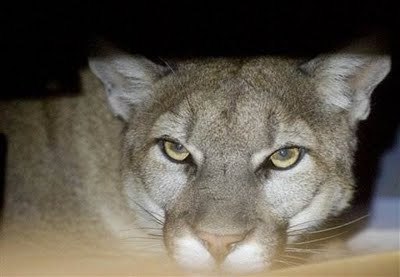
'Here, kitty': Man finds mountain lion in garage - US news - Life - msnbc.com:
""I think it was in there since Sunday night," Michelle Taylor told the Victorville Daily Press. Neighbors had seen the mountain lion roaming the area since Friday."
Wayne Alison's Cougars:
Published on May 26, 2011 11:08
May 25, 2011
Death Stories: Exhumation

Not long ago my friend Conrad said, "For a site that's supposed to hype your writing, this one has surprisingly little of your writing." Good point. So, I thought I'd write a big project of mine right here on this blog. Don't worry--I'm not going to put up my completely rough drafts (because what have you done to deserve that?), but I've mustered the courage to put up a partly-finished project in installments and try to finish it as I post over the next several months. The other stuff I usually post on the blog will still be here, just as often. This will be extra.
So, this project. It's a collection of true stories about death—human, animal, vegetable. I began writing them years ago, and even had a contract to make a book out of them. But my editor and I never agreed on the shape of that book. One of the issues, I think, was that it was just too creepy for her tastes. It is definitely creepy, and I understand that that's not to everyone's taste. I have always been a bit merciless with showing the dark side of nature, because it fascinates me and because I think there are truths there we don't often notice. The death of my death book turned into something good, because the squeamish editor kindly agreed to underwrite my slightly less gruesome Deadly Kingdom instead. But now that that book is finished , I find my thoughts turning one again to death, and all the fascination it holds.
I don't mean for this to be unremittingly dark. I am working on later chapters that show, for example, how relentlessly death foments life. We'll get to that. But for now, if you'd care to ride, I invite you to join me on the lip of the grave.
Of bodies changed to various forms I sing.
--Ovid
The wisdom of men is small, and the ways of Nature are strange, and who shall put a bound to the dark things which may be found by those who seek for them?
--Arthur Conan Doyle
Exhumation
No one knows quite how to act at an exhumation. On this cool, misty day in a cemetery in Pennsylvania, people chat and eat donuts, but keep their voices down. There is a sense of importance, and everyone faces the digging. Even when they turn to converse with each other, their feet still point toward the grave like compass needles seeking magnetic north. The words of the man in charge are repeated in reverent whispers, traveling out from the grave in waves. The people who have something to do—a videographer and his assistant, an anthropologist, a backhoe operator—work with alacrity, and those only there to watch stand around awkwardly. A daughter of the dead man gives interviews to TV reporters (who have been carefully excluded from the graveside with police tape and a canvas tent), a granddaughter stands on the edge of the grave peering in, a son wanders the cemetery smoking cigars and tapping his cane on the ground.
At the center of this activity is the lead investigator, a lean man, bald on top, with neatly trimmed white hair and beard. He wears khaki shorts with many pockets, a short-sleeved plaid shirt, a fanny pack, and a canvas hat that leaves a crease on his forehead when he takes it off to rub the sweat from his face. He moves with the loose-limbed grace of an athlete.
This man and his team have come to Pennsylvania to unearth the body of a man who died 36 years earlier, allegedly of exposure. But his family has long suspected his death was the result of racially-motivated police brutality. Race riots had troubled the town not too long afterwards. As it happens, this investigation will yield no solid clues, and the body will return to the grave. I have only the exhumation itself to tell about.
Hamlet: How long will a man lie i' the earth ere he rot?
Gravedigger: Faith, if he be not rotten before he die,—as we have many pocky corses now-a-days that will scarce hold the laying in,—he will last you some eight year or nine year: a tanner will last you nine year.
Hamlet: Why he more than another?
Gravedigger: Why, sir, his hide is so tann'd with his trade that he will keep out water a great while; and your water is a sore decayer of your whoreson dead body.
--William Shakespeare
A backhoe begins the digging, the operator careful to scrape shallowly. He's instructed to stop between bucketfuls. The leader checks to see what has turned up. At forty inches down, everything starts to look suspicious. The gummy soil is riddled with flat greenish chunks of shale. The backhoe catches a long strip of what seems to be pliable wood—perhaps part of a tree root, perhaps not. The leader orders the backhoe to stand down. Taking up a shovel, he descends into the grave himself.
He does most of the hand-digging, soon abandoning the shovel for a garden spade. Eventually, perched on the outer edges of the grave to avoid putting his weight on the fragile coffin lid, he's digging with bamboo spoons to protect any evidence he may uncover. He does take an occasional break, handing his spade to a forensic pathologist or an anthropologist and remarking, "PhD stands for Please Help Dig." It is only when he climbs from the half-dug grave, shaking slightly from his exertions, that I notice his age.
They break through the coffin lid at the foot. By this time each spoonful of dirt is being sifted for whatever might be mixed up in it. Soon a chunk of the lid has been pulled away. I glimpse vague shapes in the open space beneath. The investigators narrate their progress:
"I see a sock."
"Does there seem to be any flesh?"
"No. It feels like just bones."
From gloved hand to gloved hand, the dark reddish-brown sock is passed up with all the foot-bones inside it—a handy way to avoid losing any of them. The sock is sealed into a plastic bag and numbered. One team member writes the number in a sort of ledger, along with a description. She also writes the name of everyone who touched it. The point is to establish an air-tight chain of custody. The team must leave no opening for accusations of tampering, and they must be able to check any foreign DNA found on the body against that of the team members, so that accidental contamination can be ruled out.
Work proceeds up the body. The long bones of the legs have gone a tobacco brown. Each of them is handed up and bagged. There is no flesh—a disappointment to the team because it means some of the possible evidence has been lost to decay, but a relief, too. The work is slow and laborious. The whole exhumation will last from 8 AM to 5 PM, with a break for sandwiches and potato salad at noon. Despite the rigorously clinical handling of the remains, and the atmosphere of respectful detachment orchestrated by the leader, the exhumation begins to resemble a strip-tease. Once past the fine parts of the hand, every bone is recognizable even to a layman, and people slowly creep closer for a look. By the end everyone is crowded into the tent or around its open flap—all of the team, a few local officials, even the cemetery grounds crew. I myself am perched atop the hill of excavated earth, making notes.
"You look comfortable," someone's attorney says, smirking at me. As if I were the only voyeur.
The family have come close as well, despite the leader's advice. Even the son who lurked on the verge of the cemetery smoking cigars all day approaches and stands impassive. We are all waiting for the skull.
In your anatomy you must represent all the stages of the limbs from man's creation to his death, and then till the death of the bone; and which part of him is first decayed and which is preserved the longest.
--Leonardo da Vinci
When the leader peels away the last of the coffin lid, his back conceals everything. He looks up at the faces all around, considers for a moment, and shifts his position. Conveniently, his shifting gives me a perfect view. The face, like most of the body, is void of flesh. A conchoidal section of skull is caved in, but this proves nothing. Though it might be evidence of a violent death, the break might also have occurred post-mortem. Radiologists will consider such factors as the pattern of striations generated by the fracture and any evidence of bleeding before they draw conclusions.
From the back of the skull sprouts a fan of orange-yellow material, like the radiant crown in a painting of a saint. I imagine for a nauseous moment that this is some organic material leaked from the skull. "Foam," the leader says, and hands the whole mass up. The foam from the coffin pillow, matted together where fluid long ago leaked from the body.
Later, at a restaurant where the leader treats the entire team and a few hangers-on to authentic Pennsylvania cuisine, including hoe-cakes and a dish made of pureed pumpkin, he grows reflective. He strokes his trim white beard with his thick-knuckled hands, the nails of which are noticeably free of dirt.
"The skull is always an issue," he tells me. "I tried to keep the skull turned." His hand takes hold of his own chin and guides it to the side, illustrating. "I didn't want them to see it."
He explains that in another case, a son at the graveside had a clear view. "He looked into his father's mummified face, and it was his own."
Published on May 25, 2011 11:45
May 24, 2011
Clumsy bear attacks
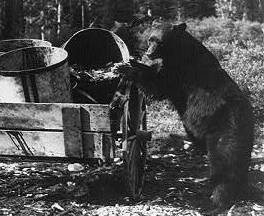
Woman survives bear attack after being confronted by beast in own home | Mail Online:
"She tried to escape inside, but the bear rammed her against the patio doors, smacking her head against the glass and trapping her hand.
The animal tried to get away, but fell through a fence and dropped eight-feet off the back deck of Mrs Berghorn's home. "
Published on May 24, 2011 14:07
May 23, 2011
The Rabbits of Spring

I know it's already hot in some places, but here in Wisconsin spring still feels new. The cottontailed rabbits have emerged, looking thin and disheveled. They'll fatten as the season warms up.
Cottontails eat clover and dandelion, among many other things, so they often venture onto lawns. D'Arcy caught this one in a few candid moments.



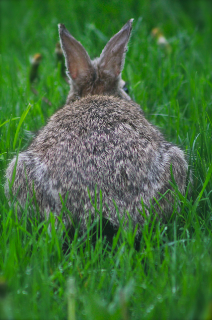

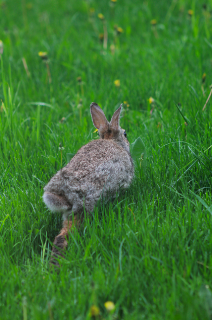

Published on May 23, 2011 15:36
May 21, 2011
Spider in Amber
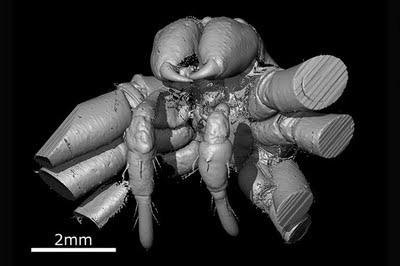
Live Science has this interesting report about an ancient huntsman spider preserved in amber.
(Thanks to Faye for the news tip.)
Other fossil spider images:

Published on May 21, 2011 14:11
May 19, 2011
Moose attacks girl
 Photo by Wayne T. Allison
Photo by Wayne T. AllisonAnchorage police kill moose after it attacks girl - Sacramento News - Local and Breaking Sacramento News | Sacramento Bee:
"A moose attacked a girl on a bicycle after Anchorage police say the animal had given birth to twins a day earlier.
Police killed the moose after the attack Wednesday.
The child who fell from her bike sustained injuries to her head, but they are not considered life threatening. She's been hospitalized."
Yet another reason to always wear your bike helmet.
Published on May 19, 2011 10:05
May 17, 2011
Grizzly bear attack leaves man in critical condition
Local News | Grizzly bear attack sends Alaskan to Seattle hospital | Seattle Times Newspaper:
"The bear lay in the deep snow beside a creek. Perkins, riding ahead of his partners, passed the animal. He drove another 70 feet and turned around, troopers say.
The grizzly charged. Perkins, still on his snow machine and handling gear, wasn't able to get out of the way, according to troopers.
'My understanding is that it was a very large bear. One of the biggest that people have seen around here,' Johnson said."
"The bear lay in the deep snow beside a creek. Perkins, riding ahead of his partners, passed the animal. He drove another 70 feet and turned around, troopers say.
The grizzly charged. Perkins, still on his snow machine and handling gear, wasn't able to get out of the way, according to troopers.
'My understanding is that it was a very large bear. One of the biggest that people have seen around here,' Johnson said."
Published on May 17, 2011 14:56



